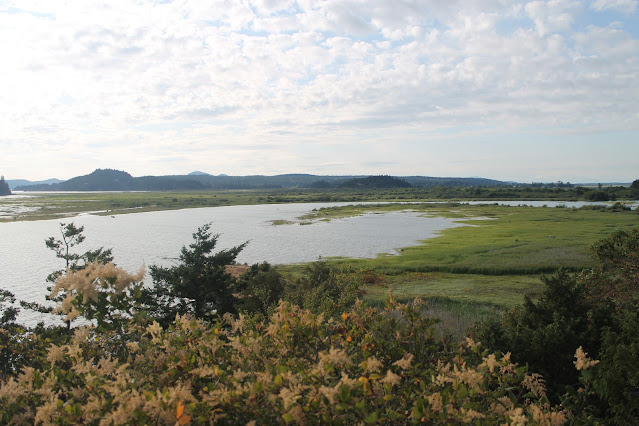As Dorothy and I well know, when you are this close to Emerald City, you could encounter lions, and tigers and bears. Oh, my!
 |
| Maurice returns to my (or is it his?) apple orchard to check on this year's apple crop |
 |
| I'll be back - Maurice (July 8, 2025) |
Well, so far, it is 2 out of 3 for lurking dangers on The Pilchuck.Maurice, the black bear, has been seem three times in the first half of 2025 [as far as I know, maybe more]. He first stopped by the place on April 30th. He and I exchanged surprised looks a few weeks later as I was heading down the driveway to throw away a spoiled piece of ham into the trash can before the trash was to be picked up later that Wednesday afternoon. Maurice was coming down the road that joins the driveway at the 'Y'. Maurice's chosen path that morning splits off the driveway and leads into the back 40.
I saw him and I stopped in my tracks.
He saw me and he stopped in his tracks.
Maurice beat it into the forest brush and I tossed the piece of meat in his direction and returned to the house. Win - win.
Maurice was back on July 8th to shake my tree. The apples are not yet ripe, so I expect him to be back later in the month. He really loves my apples and wants to shake my tree. [Ref. The Joker, Steve Miller Band
***
What I did not expect was to meet a lion on The Pilchuck. I'm not making this up - yes! A lion.
I was looking out my dining room window in the late dusk July 11th and noticed two does back grazing in my field, as they often do in the evening. I was on the phone with Sue and made mention that my deer friends were back this evening. I pointed the phone out the window at her request in hopes she could also see the does. They were about 300' away and not easily seen on the phone's screen.
The two does were walking in the knee-high green grass and yellow flowers with stiff-legged, dainty and cautious steps. Unusual gait, I thought to myself.
I returned to my chair and turned to watch the deer, but they were suddenly gone. Often they will slowly graze and move across the field in a casual nonchalance. I looked harder to see where or why they had disappeared from my view so abruptly.
I saw my answer prowling up the edge of that field along my driveway. I saw a large mountain lion coming toward my house. I stayed on the phone with Sue describing the incredible sight of seeing a cougar hunting out in the open just outside my dining room window. I flipped my cell phone into camera mode while still doing play-by-play on the lion hunt happening before my eyes.
The deer must have sensed the predator in their midst and bounded for safety somewhere out of sight. I tracked the mountain lion moving closer to the house, holding my camera on this amazing animal. I moved from the dining room to the living room window to get a better angle on the stalking wildcat. I watched as it came up to my SUV and slipped behind the far side. Anticipating that the lion would pass along the north side of the house, I walked briskly to the window in the door for my back porch. Still calling the play-by-play, I said to my wife; "He's heading for my back porch, I'm going to make sure that door is locked." I don't have door knobs, I have lever handles on my doors, the kind of shiny silver things that just might attract the attention of any kitty cat to swipe at - and then find that in swiping at it, it opens into my mudroom.
Expecting the cougar to walk past my house, I was surprised to look out my porch door window to see that it had silently climbed the steps and was standing two feet on the other side of my door. I pointed my video camera, the wildcat unaware of my nearby presence as I was recording it at a little more than whisker-length away from its fangs. I threw the bolt on my door lock as the cat paused, looked into the woods, its whole, long, sleek, golden body taking up the length of my porch before it make a quick move, turned around and walked into my backyard and disappeared into the thimble berry thicket.
Sue was begging for me to send her my pictures of the mountain lion. I checked my photo gallery only to face great and sincere heartbreak. I had not realized that I had not activated my video on my phone. Such a once-in-a-lifetime opportunity to record a lion on my back porch from two feet away was gone. Dreadful sorry to have messed up this amazing opportunity. I try to live a life of few regrets, but this failure has to count for a huge regret in my life.
Who knows? I may get to see this mountain lion again - but I am not so sure that I want to encounter a prowling lion in the forest on my 50 acres. It was exciting to see it come up to my porch while I was safe inside. Not as eager to meet him on his turf, even if I technically have title to this plot of land.
I googled 'Mountain Lion deaths in US', finding the AI answer that mountain lions attacks and deaths in the US are rare, [about 32 human deaths in the last century] but do happen.
***
I've enjoyed having numerous guests come to The Pilchuck this summer. Sue flew up to Seattle in mid-June. A few days later we two were joined by our son Grant, his wife Kaileen from New York City and her parents from the Houston area for several days. Later, Inga and Sean came up from Portland for a visit. While the family was here, the major wildlife sightings were absent.
Once all of my guests left, I have seen deer, bear and a mountain lion. The apex predators have come to pay me a visit. Lions and tigers and bears! Oh, my!
Well - two out of three.
I let you know if I catch a tiger by the tail. But right now I've got a mountain lion by the 'tale'.
.jpg)



















.jpg)





























